Introduction
In the rapidly evolving landscape of cloud computing, organizations are increasingly recognizing the pivotal role of cloud orchestration and automation in driving operational efficiency and agility. As businesses strive to navigate complex IT environments, the ability to automate processes and coordinate resources effectively becomes essential.
This article delves into the fundamental concepts of cloud orchestration and automation, exploring their significance in modern cloud management strategies. It outlines the myriad benefits of implementing these practices, shares best practices for successful execution, and highlights the importance of selecting the right tools.
Additionally, it examines emerging trends that are set to shape the future of cloud orchestration, providing valuable insights for organizations seeking to maintain a competitive edge in an increasingly digital world.
Understanding Cloud Orchestration and Automation
Cloud orchestration and automation encompass the automated arrangement, coordination, and management of intricate computer systems, middleware, and services, facilitating the efficient delivery of IT services. On the other hand, cloud orchestration and automation in the computing environment utilize software to create repeatable instructions and processes, significantly reducing the necessity for human involvement in IT operations. Mastering these two concepts is crucial, as they support contemporary management strategies and enable entities to achieve agility, scalability, and operational efficiency in their IT environments through cloud orchestration and automation.
With Amazon Web Services (AWS) commanding 31% of the infrastructure services market, Microsoft Azure at 25%, and Google Cloud at 10%, these three major players together account for 66% of the market share. This highlights the significance of a strong management approach for entities striving to stay competitive in a progressively digital environment. According to Cody Slingerland, 'Together, these two regions represent 82% of the world’s computing services,' which highlights the dominance of these key players.
To prosper, companies must implement effective strategies for cloud orchestration and automation to improve IT efficiency. Additionally, findings from the case study named 'Future Trends in Computing' show that emerging technologies and shifting business requirements are influencing the future of computing, suggesting that organizations that employ cloud orchestration and automation will probably remain ahead in this changing environment.
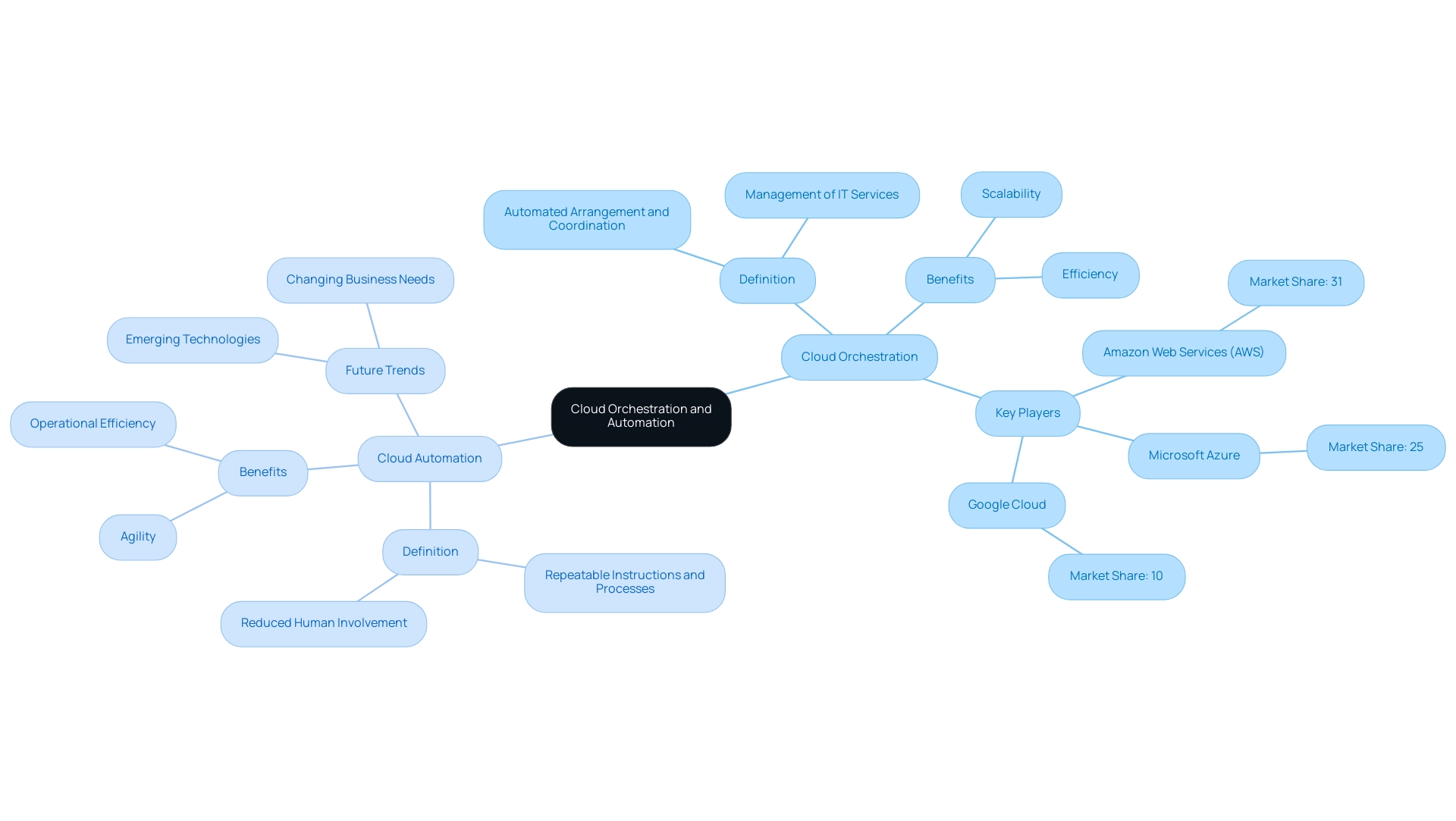
Benefits of Implementing Cloud Orchestration
The execution of digital management offers numerous benefits, primarily including improved operational efficiency and substantial decreases in deployment durations. Organizations leveraging automated workflows can experience reductions of up to 30% in the time allocated to manual processes, streamlining operations and freeing up valuable resources for strategic initiatives. Moreover, efficient coordination enables enhanced resource management, permitting optimal workload allocation across hybrid computing environments.
This careful balancing not only mitigates the risk of over-provisioning but also leads to cost reductions and improved agility. As reported, companies implementing a hybrid infrastructure strategy have observed a significant 42% rise in agile development environments, highlighting how coordination abilities can enable organizations to stay adaptive to changing industry demands. As stated by industry leaders, a significant trend in the online management market is the rise of cloud orchestration and automation, which highlights the importance for companies to embrace these contemporary solutions to improve their competitive advantage in 2024 and beyond.
Furthermore, it's significant that 67% of manufacturers are employing internet-based systems to streamline supply chain operations, while 91% of financial institutions utilize online services for enhanced data security. These statistics emphasize the extensive embrace of digital management across different sectors. For example, a recent case analysis on trends in the virtual infrastructure market demonstrates how companies have successfully adopted these strategies, leading to substantial operational efficiencies and improved performance.
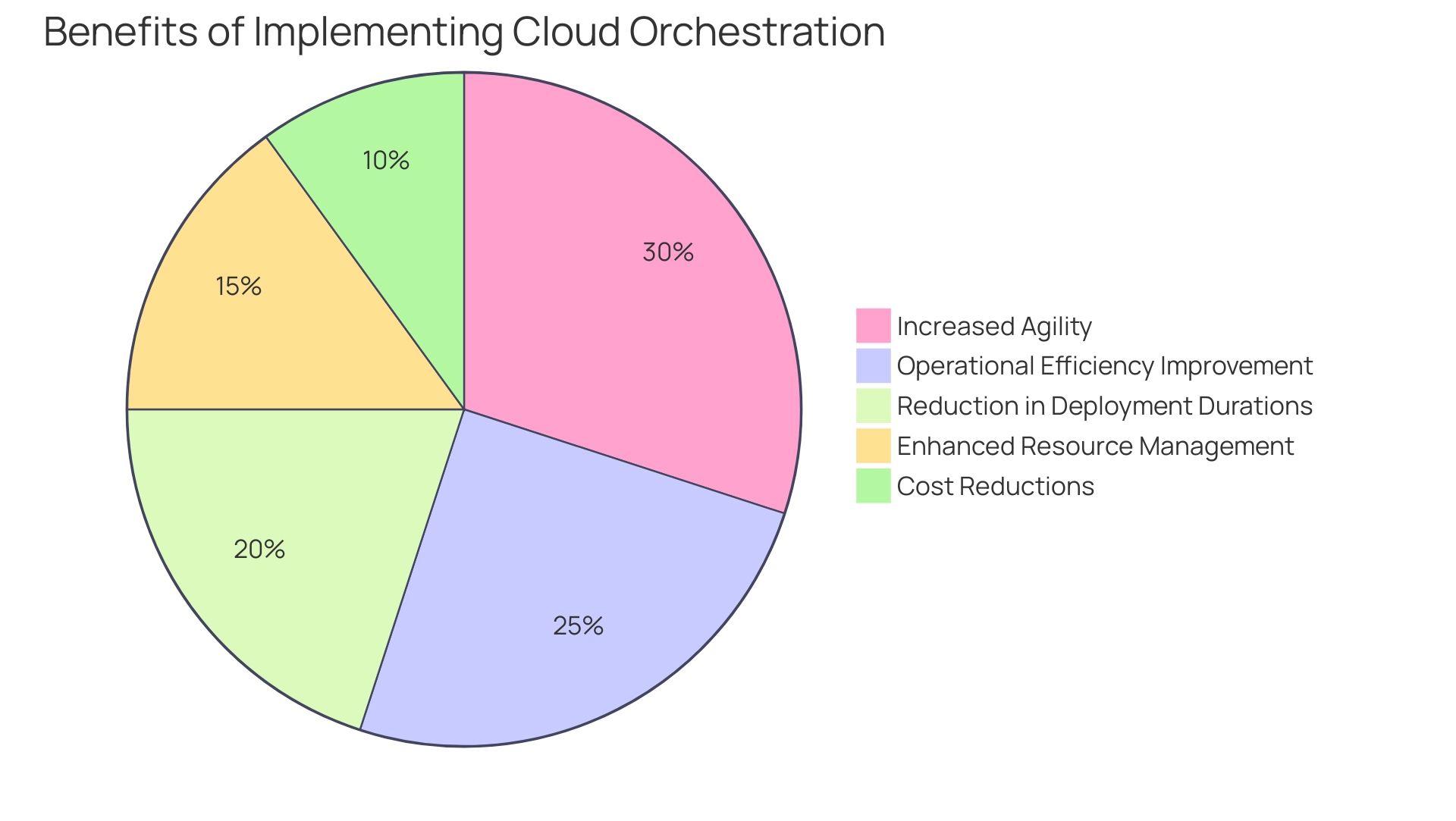
Best Practices for Successful Cloud Orchestration
Achieving successful cloud orchestration requires organizations to adopt several best practices:
- Define Clear Objectives: It is essential to establish specific goals for orchestration, such as enhancing response times or driving down operational costs. Clarity in objectives lays the groundwork for effective implementation.
- Utilizing robust cloud orchestration and automation tools is crucial. These tools should integrate seamlessly with existing infrastructure to maximize efficiency and minimize disruption during the transition.
- Implement Continuous Monitoring: Regular monitoring of orchestrated workflows enables organizations to identify performance bottlenecks swiftly and optimize their processes accordingly. Continuous monitoring is essential for ensuring the resilience and adaptability of online operations. Notably, 72% of respondents are working towards unifying security with observability and monitoring to address dynamic security threats, highlighting the importance of this practice.
- Prioritize Security: Considering that 72% of companies regard cloud security as a major issue, integrating security protocols throughout the management process is essential. This approach not only safeguards sensitive data but also ensures compliance with regulatory standards. As emphasized in the DevOps Pulse 2023 report, "72% of respondents said they are unifying security and observability/monitoring."
- Foster Collaboration: Encouraging cross-departmental teamwork is key to aligning all stakeholders with the coordination strategy. This collaborative culture enhances communication and ensures that diverse viewpoints contribute to the coordination efforts. Moreover, 70% of IT leaders think that possessing a hybrid computing strategy is essential for attaining successful digital transformation, emphasizing the necessity for effective coordination in this context.
By adhering to these best practices, companies can effectively manage the intricacies of virtual infrastructure, ultimately supporting their agile transformation goals with cloud orchestration and automation.
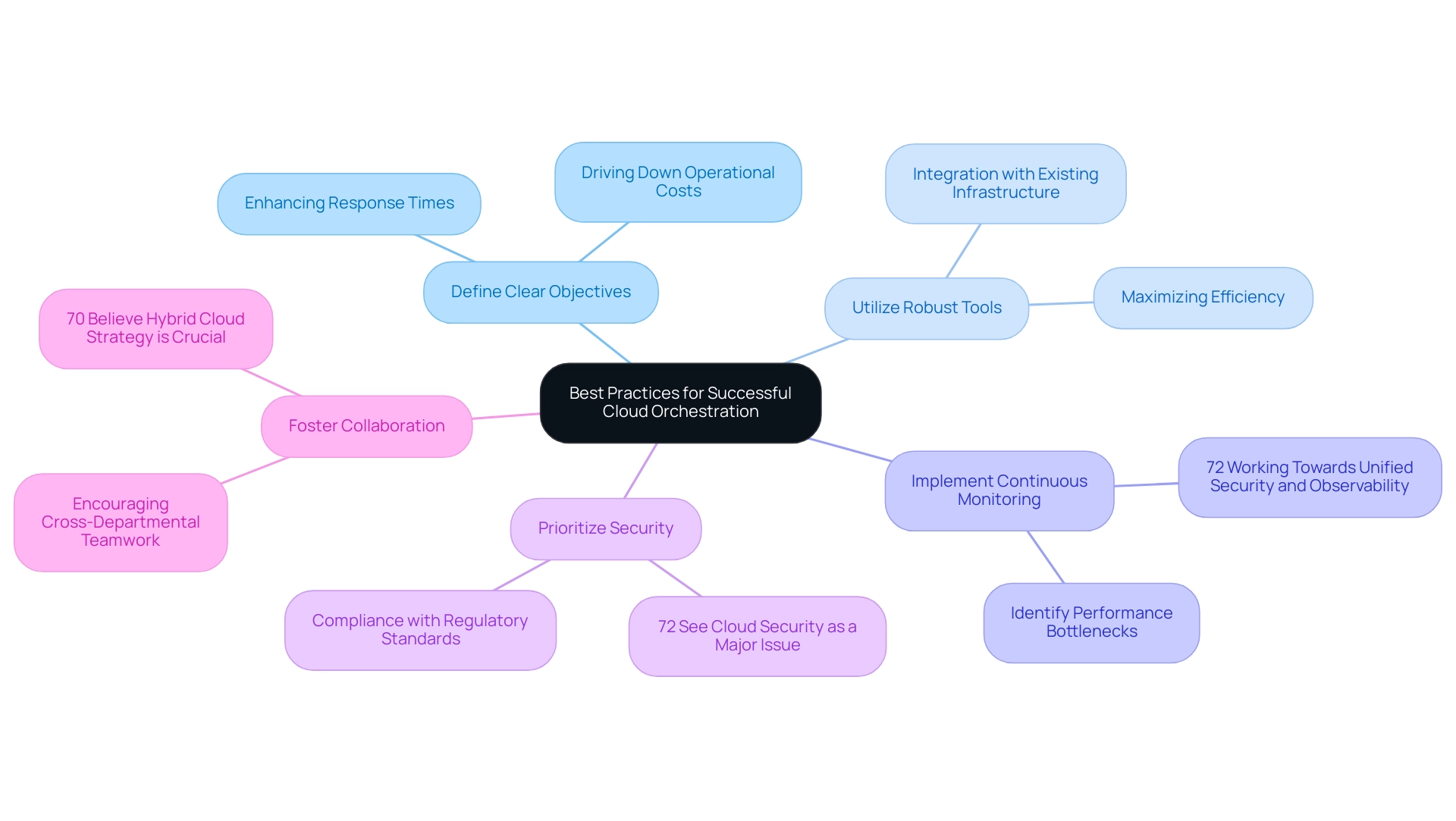
Choosing the Right Tools for Cloud Orchestration
Choosing the appropriate instruments for online management is essential, especially as companies progress through their agile transformation journeys. It is essential to assess coordination options based on several key criteria:
- Scalability
- Ease of integration
- User-friendliness
- Cost management
As a significant trend in the cloud management sector, there is a rise in cloud orchestration and automation, highlighting the necessity for organizations to be strategic in their tool selection.
Prominent tools available include:
- Kubernetes: Widely acknowledged for its strong container management abilities.
- Terraform: Excels in infrastructure as code.
- AWS CloudFormation: Designed for effectively managing AWS resources.
Each of these tools presents unique features that cater to different organizational needs. For instance, Kubernetes holds a significant market share due to its versatility, while Terraform is favored for its declarative approach to infrastructure management.
Moreover, AWS CloudFormation is often chosen for its seamless integration with AWS services. A thorough assessment of your specific requirements and existing technology stack is paramount. Furthermore, considering vendor support and community engagement can significantly influence the long-term success of your coordination strategy.
Significantly, a case study indicated that 75% of firms reported a rise in waste related to digital storage solutions, with potential waste reaching up to 47% of a budget. This emphasizes the significance of cost management when choosing coordination tools. As the market for managing distributed systems expects a compound annual growth rate (CAGR) of 16% from 2024 to 2033, organizations must make informed choices to remain competitive in this swiftly changing environment.
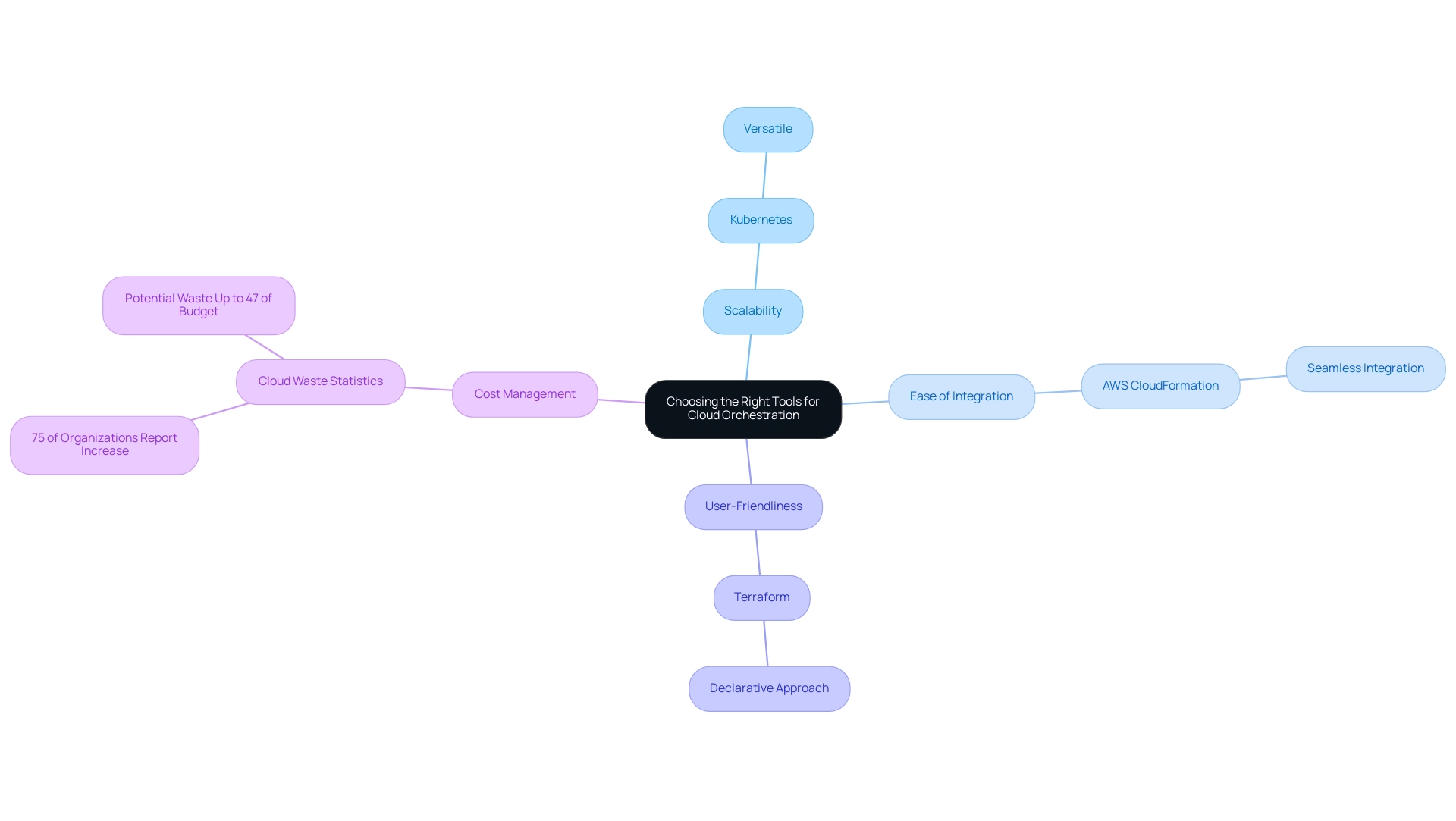
Future Trends in Cloud Orchestration and Automation
As cloud technology continues to transform, several key trends are shaping the landscape of management and automation:
-
AI and Machine Learning Integration: The incorporation of AI and machine learning is set to transform management capabilities, enabling more intelligent resource oversight and predictive analytics. According to industry insights, from 2020 to 2022, investment in AI startups surged by US $5 billion, nearly doubling previous investments. This trend underscores the commitment to leveraging AI for enhanced operational efficiency. Moreover, entities are increasingly focusing on AI governance and sustainability practices, with 40% prioritizing governance and 37% on sustainability training, indicating a strategic shift towards responsible AI use that incorporates cloud orchestration and automation.
-
Serverless Architectures: A significant shift towards serverless computing is underway, enabling organizations to reduce manual management efforts and maximize operational efficiency. By abstracting server management, businesses can focus on application development and delivery, leading to faster time-to-market.
-
The increasing use of hybrid and multi-cloud environments requires advanced management tools that enable effective cloud orchestration and automation of diverse resources. Organizations are increasingly recognizing the need for seamless integration across platforms to optimize performance and maintain flexibility.
-
Enhanced Security Measures: As cyber threats evolve, there is a critical need to integrate security into the management process from the outset. This proactive approach is essential for safeguarding online environments and ensuring compliance with regulatory standards.
Additionally, with the Electric Motor Market expected to reach USD 272.2 Billion by 2033, the implications for technological advancements are significant, potentially influencing online management strategies.
Staying attuned to these trends is imperative for organizations aiming to harness the full potential of internet technology. With the market for Natural Language Processing expected to surpass US $60 billion by 2030, the implications for cloud orchestration and automation in cloud computing are profound, paving the way for innovative solutions and strategic advancements.
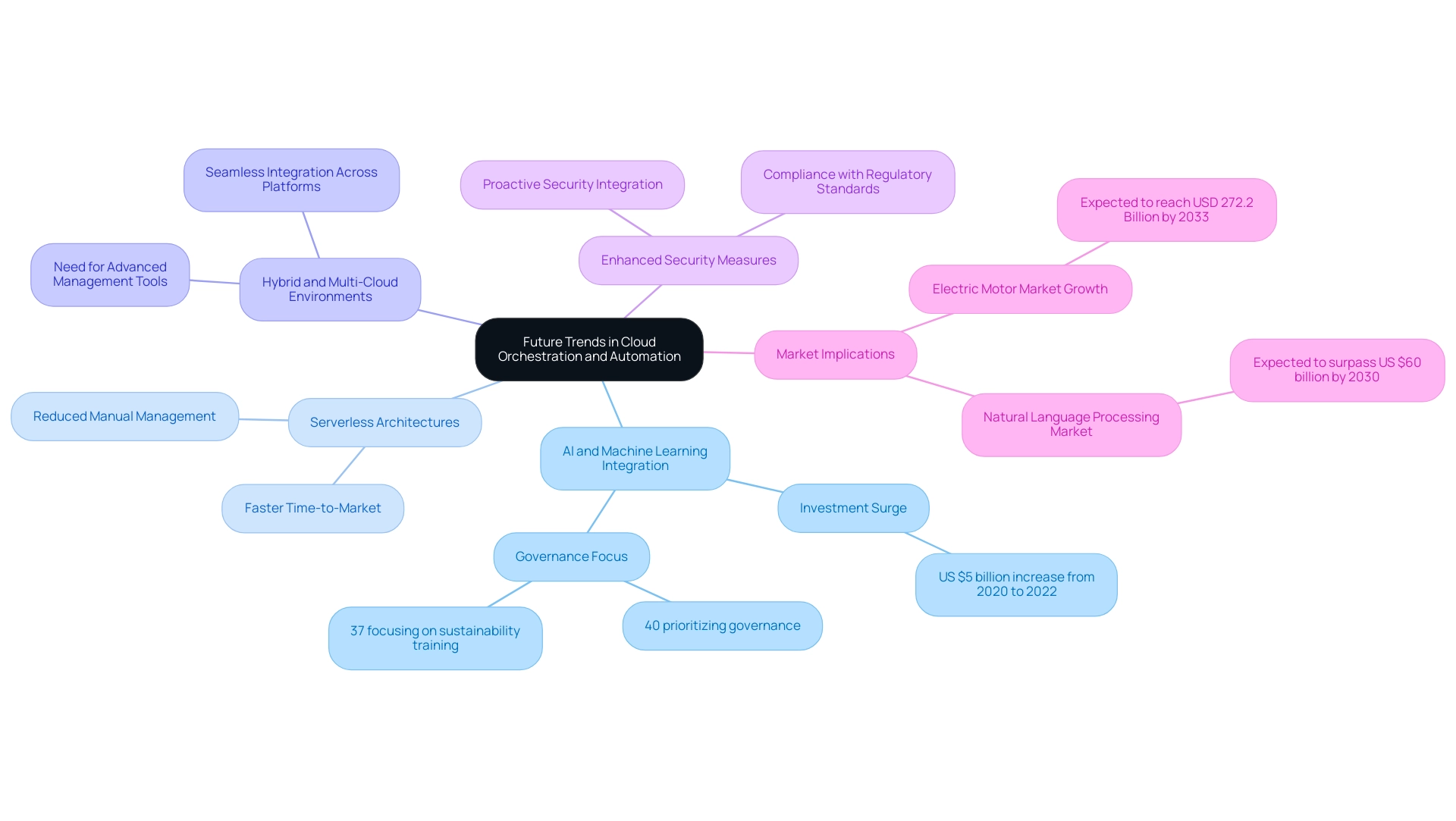
Conclusion
In the realm of cloud computing, the significance of cloud orchestration and automation cannot be overstated. These practices serve as the backbone of modern IT management, fostering operational efficiency and agility within organizations. By automating processes and coordinating resources, businesses can not only reduce deployment times but also optimize resource management across diverse environments. The compelling statistics, such as a 30% reduction in manual processes and a 42% increase in agile development environments, highlight the transformative potential of effective orchestration.
Implementing best practices is crucial for harnessing the full benefits of cloud orchestration. Establishing clear objectives, leveraging appropriate automation tools, and prioritizing security are essential steps that organizations must undertake. Furthermore, fostering collaboration among stakeholders ensures that the orchestration strategy is comprehensive and well-aligned with organizational goals. As companies increasingly adopt hybrid cloud strategies, the role of effective orchestration becomes even more vital, enabling businesses to adapt swiftly to changing market demands.
Looking ahead, emerging trends such as AI integration, serverless architectures, and enhanced security measures are set to redefine the landscape of cloud orchestration and automation. Organizations that stay attuned to these developments will be better positioned to leverage cutting-edge technologies and maintain a competitive edge in an evolving digital environment. By embracing these innovations, businesses can streamline their operations, safeguard their data, and ultimately drive sustainable growth in the cloud era.




